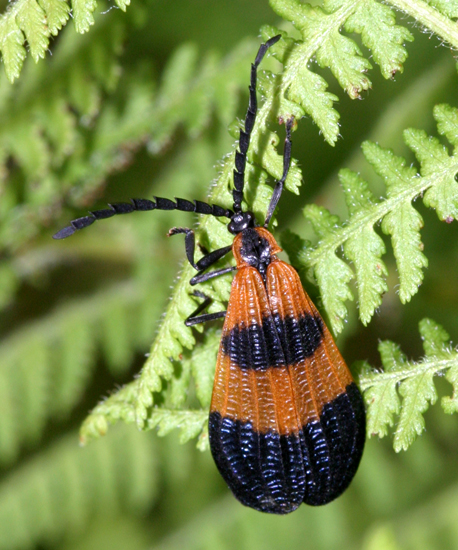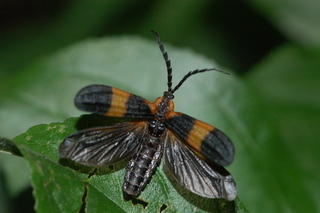Where can you find Calopteron reticulatum?
Calopteron reticulatum is an arthropod
that commonly inhabits dead, decomposing wood. The beetle not only
lays its eggs in the dead, decomposing wood, but it also utilizes
the wood as a food source. C. reticulatum creates tunnels for its
eggs as it eats through the wood. In addition to inhabiting dead,
decomposing wood, C. reticulatum has also been known to live within
forest litter and soil. Soil and forest litter are also good places
for C. reticulatum to find more decomposing food (Bocak and Matsuda
2003). Also, with respect to the fact that these beetles can be
found in forest litter, and on logs and plants,
 they
cannot survive in flightless habitats like caves (Malohlava and
Bocak 2010). Caves consist of dark and sometimes wet environments,
but they are also fairly cool at around 50 degrees Fahrenheit.
Additionally, there are no plants within caves for C. reticulatum to
feed on and no place to lay their eggs.
they
cannot survive in flightless habitats like caves (Malohlava and
Bocak 2010). Caves consist of dark and sometimes wet environments,
but they are also fairly cool at around 50 degrees Fahrenheit.
Additionally, there are no plants within caves for C. reticulatum to
feed on and no place to lay their eggs.
Additionally, Malohlava and Bocak (2010) also discovered that other
net-winged beetles in the Lycidae family do not tend to disperse
into different habitats, but rather they have evolved genetically to
survive in the habitats for which they stay. These beetles can
survive in habitats ranging from humid and wet to warm and moist. In
the winter though in the boreal forest and temperate grassland
regions, food availability is low as plants cease growth until
spring and temperatures can drop below zero. During the summer
months, these regions are warm and moist and the beetles are
actively feeding on plants and reproducing whereas during the cold
winter months, they stay in a dormant state until spring comes.
Additionally, these C. reticulatum beetles like other arthropods and
animals alike demonstrate a proximate behavior in response to food
availability and low temperatures.
C. reticulatum is also considered a detritus feeder in the food
chain because it feeds on decaying matter, but it also feeds on
plant juices for which it utilizes as energy for reproduction and
gives to its young (Bocak and Matsuda 2003; Hall and Branham 2013).
Also, according to Aristizábal et al. (2013), C. reticulatum not
only feeds on plant juices, but it is also a predator to foliage
plants in Colombia. Additionally, not only were these beetles found
to predate foliage plants, but they also demonstrated a
commensalistic relationship with the plants because they predated on
leafhopper nymphs (Aristizabal et al. 2013).
In geographical terms, the beetle has been found in portions of the
United States as well as in the tropics. In the United States, C.
reticulatum has been found in the Northeastern and Great Plains
regions which includes the upper New England states like Maine, New
Hampshire, Vermont, New York, and New Jersey; and Oklahoma in the
Great Plains. In the tropics, C. reticulatum has been found in the
rainforest where there is constant life and decaying of organic
organisms and plant matter. (Dunn 1996: 178; Hall and Branham 2003).
Additionally, many photographs that have been taken of C.
reticulatum, show the beetle crawling around plants. These beetles
like other arthropod and mammalian species are known to be repelled
and attracted to the scents that plants send out to pollinators. In
addition to C. reticulatum acting as a vector and a predator to
plants, geographically, C. reticulatum and other lycidae beetles
have converged and evolved to defend and mimic each other with their
wing coloration (Bocak and Yagi 2010). In a study done by Bocak and
Yagi (2010), mimicry patterns were recorded among species of lycidae
where they considered each new wing pattern to be a characteristic.
Within their system, one characteristic pattern may have been black
with a red hue and another may have all black (Bocak and Yagi 2010).
In addition to these characteristics, Bocak and Yagi (2010)
collected these beetle specimens from geographically different
locations. In an evolutionary perspective, it is highly likely that
C. reticulatum has migrated to temperate and tropical regions around
the world given the specimen locations. Also, according to Bocak and
Yagi (2010), location did not seem to make any difference because
the predators turned away from the lycid beetles that had bright
coloration.
Come learn more about the Banded Net-Winged Beetle's
Form and Function

